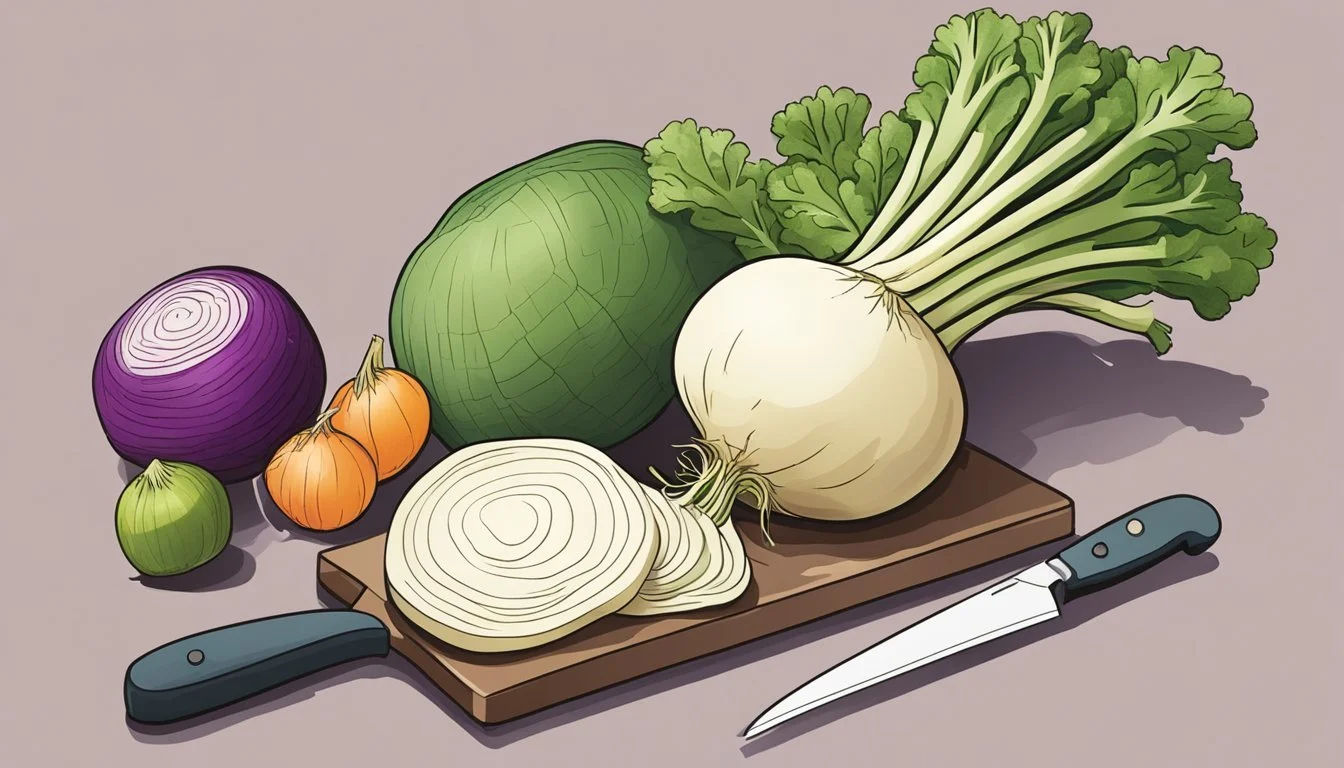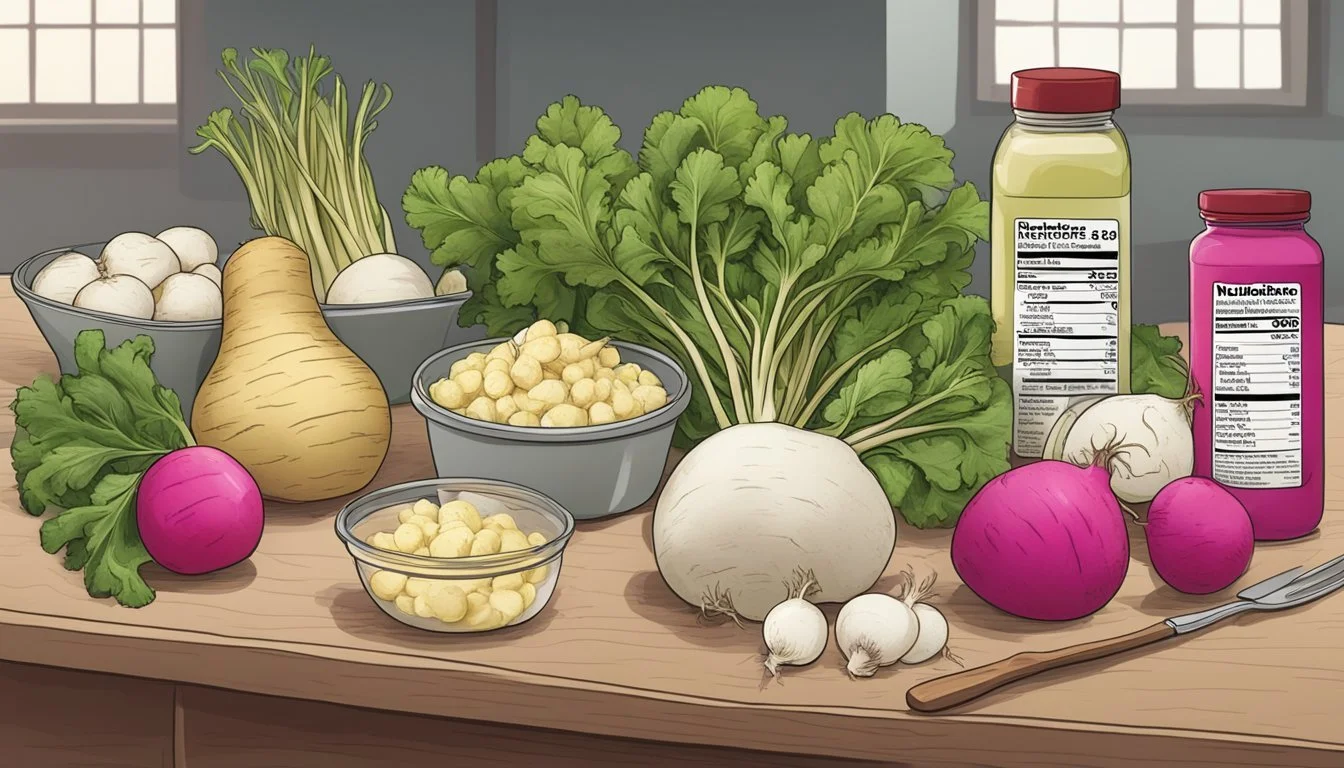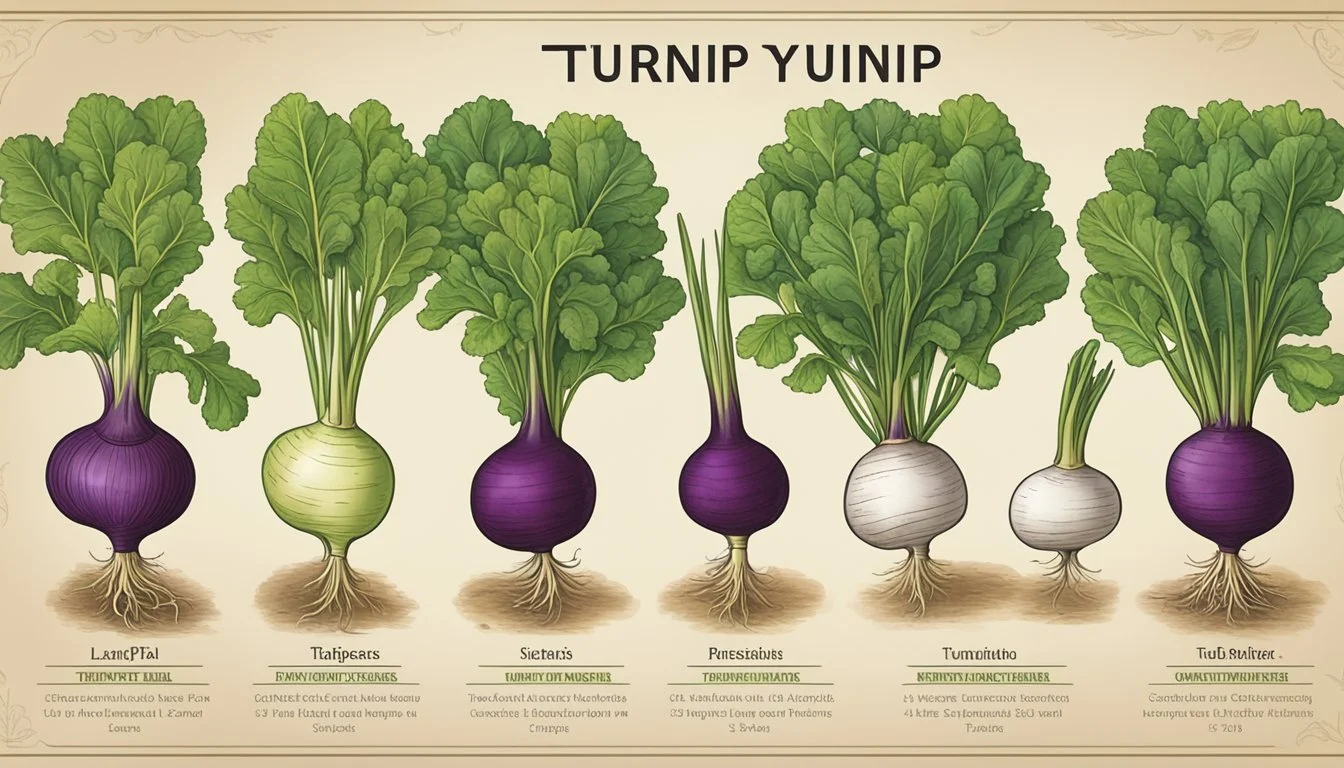Turnips Substitutes
Best Alternatives for Your Recipes
Finding a good substitute for turnips can enhance your cooking experience without compromising on flavor or texture. Swedes, also known as rutabagas, are the closest match to turnips, offering a similar earthy taste and firm texture. Many chefs and home cooks alike turn to swedes for this very reason.
Kohlrabi stands out as another excellent option. Although it belongs to the cabbage family, its slightly sweet and peppery flavor mimics that of turnips. For those looking for something different, jicama or potatoes can also serve as adequate substitutes, adding their own unique twist to recipes.
If you're looking for a convenient and flavorful alternative, consider using chopped carrots, which can replace turnips in equal measure. These versatile root vegetables can seamlessly integrate into your favorite dishes, ensuring you achieve the desired taste and consistency.
Understanding Turnips
Turnips are versatile root vegetables known for their earthy flavor and crunchy texture. They offer various health benefits and can be utilized in numerous culinary applications ranging from soups to salads.
Nutritional Profile
Turnips are nutritious and low in calories, making them an excellent choice for healthy eating. They are rich in fiber, which aids digestion and promotes satiety. Turnips also contain essential vitamins and minerals, including vitamin C, potassium, and calcium.
The leaves of the turnip plant are edible and packed with nutrients. They offer high amounts of vitamin A, K, and folate, contributing to a well-rounded diet. Incorporating turnips into meals can help enhance overall nutrient intake.
Culinary Uses
Turnips can be prepared in numerous ways, making them a staple in various recipes. They can be used in stews, roasted for a sweet and caramelized flavor, or added to soups for a hearty texture.
Raw turnips can be sliced and added to salads, offering a crispy element. The greens can be sautéed or used in stir-fries, adding a nutritious punch to any dish. Their versatility extends to being mashed or pickled, catering to diverse taste preferences.
Distinctive Characteristics
Known for their earthy flavor and crunchy texture, turnips have a white interior with a purple-tinged outer skin. They can range in size from small, tender young turnips to larger, more mature varieties.
The young turnips are milder and slightly sweet, whereas mature turnips have a more pronounced flavor. The edible leaves, also known as turnip greens, have a slightly bitter taste and are highly nutritious. These characteristics make turnips a unique and valuable addition to any culinary repertoire.
Top Turnip Substitutes
Turnip substitutes bring unique flavors and textures to a variety of dishes. Each alternative offers distinct qualities, making them suitable for different kinds of recipes, whether roasted, mashed, or added to soups and stews.
Rutabagas for Hearty Dishes
Rutabagas, also known as swede, are closely related to turnips and make an excellent substitute in many recipes. This root vegetable has a slightly sweeter and less bitter taste compared to turnips. They are particularly well-suited for hearty dishes, including stews and casseroles.
Rutabagas can be roasted or mashed similarly to turnips, providing a creamy texture when cooked. Their mildly sweet, earthy flavor adds depth to dishes. Because they are denser than turnips, they may require a bit more cooking time to achieve the desired tenderness.
Celeriac for Unique Flavor
Celeriac, also known as celery root, offers a unique flavor that combines the mild taste of celery with a nutty undertone. This makes it an interesting substitute for turnips, especially in recipes where an additional layer of flavor is desired.
Celeriac is versatile and can be used in soups, stews, or roasted dishes. Its texture is firm yet becomes tender when cooked. It may need peeling to remove the rough outer skin before being chopped or sliced for cooking. Celeriac's distinctive flavor profile enhances the taste of many dishes, making it a favorite among chefs looking to add complexity to their recipes.
Parsnips for Sweetness
Parsnips are another excellent substitute for turnips, particularly for those who prefer a sweeter taste. This root vegetable, which resembles a carrot, has a natural sweetness that intensifies with cooking. Parsnips are ideal for roasting or adding to soups and purees.
Parsnips' high sugar content caramelizes beautifully when roasted, providing a delightful contrast to savory ingredients. They can be mashed or pureed to create a creamy side dish that pairs well with meats and other vegetables. Parsnips' versatility and pleasantly sweet flavor make them a great alternative to turnips in many recipes.
Alternative Root Vegetables
Turnips can be substituted with several other root vegetables, each of which brings its own unique flavor, texture, and nutritional benefits. Among the options available, carrots are appreciated for their versatility, potatoes offer various forms, and radishes add a spicy kick to dishes.
Carrots for Versatility
Carrots, with their sweet and earthy flavor, are an excellent substitute for turnips. They can be steamed, boiled, roasted, or even eaten raw, offering flexibility in cooking. Carrots are rich in vitamins A, K, and C, providing nutritional benefits while substituting for turnips.
Their crunchy texture holds up well in soups and stews, making them a reliable addition to various dishes. When using carrots instead of turnips, consider their sweetness, which may alter the overall taste of the recipe. Adjust seasoning if needed to maintain balance.
Potatoes in Various Forms
Potatoes are a widely available root vegetable that can replace turnips. They come in many varieties, such as russet, red, and sweet potatoes. Potatoes can be boiled, baked, mashed, or fried, making them extremely versatile. Their mild flavor is an excellent canvas for absorbing seasonings and other flavors in a dish.
When substituting turnips with potatoes, especially in recipes like stews or roasts, the cooking times are comparable. Potatoes also offer a good amount of vitamin C, B6, and potassium. Be mindful of the different textures, as turnips are slightly firmer.
Radishes for Spiciness
Radishes, including the milder daikon radish, provide a spicy and peppery alternative to turnips. Their crisp texture and distinct flavor add a zing to salads, stir-fries, and roasted vegetable dishes. Radishes are low in calories and rich in vitamins C and B6.
When cooked, radishes mellow out, losing some of their spiciness while retaining a pleasant crunch. This makes them a suitable substitute for turnips in both raw and cooked forms. Radishes’ strong flavor can enhance the dish, so adjust spices accordingly to avoid overpowering the meal.
Unique Substitutes
This section explores three unique substitutes for turnips that bring distinct textures and flavors to your dishes. Each has its own characteristics, making them suitable for various culinary applications.
Jicama for Crunch
Jicama, sometimes called the Mexican potato, offers a mild sweet taste and a slightly starchy texture. It can be an excellent turnip substitute, especially in dishes where a crisp texture is desired. Jicama works great in salads, adding not only crunch but also a good source of dietary fiber, Vitamin C, folate, magnesium, and potassium. This root vegetable can also be baked or fried, maintaining its texture well during cooking.
Salsify for European Cuisine
Salsify, a root vegetable often used in European cooking, has a unique, slightly savory flavor reminiscent of oysters. When replacing turnips in recipes, salsify provides a delicate texture that can complement soups, stews, and creamy dishes. Its subtle taste blends well with various ingredients, making it a versatile option. Salsify is sometimes referred to as the "oyster plant," fitting in seamlessly with traditional European cuisine and adding an exotic touch to your meals.
Kohlrabi for Texture
Kohlrabi, a member of the cabbage family, presents itself as a versatile turnip substitute due to its slightly sweet, peppery flavor and firmer texture. This vegetable can be sliced, diced, or shredded for use in salads or cooked dishes. Kohlrabi's firmness makes it an excellent option for recipes requiring substantial texture. It is also suitable for roasting, steaming, or stir-frying, where it can retain its crunch while absorbing the surrounding flavors.
Preparing Substitutes
When substituting turnips, it’s essential to understand the cooking techniques and flavor adjustments needed to achieve a comparable result. Different substitutes have unique textures and flavors that may require specific preparation methods.
Cooking Techniques
Roasting: Many turnip substitutes like swede, parsnips, and jicama benefit from roasting. Simply cut into uniform pieces, drizzle with oil, and season with salt and pepper. Roast at 400°F (200°C) for 25-30 minutes until tender and slightly caramelized.
Boiling: For a softer texture, boiled substitutes like potatoes or celery root can be used. Cut into small chunks and boil in salted water for 10-15 minutes, or until tender. This method is ideal for mashing or adding to stews.
Deep-frying: Deep-frying is excellent for jicama or parsnips, providing a crispy exterior while maintaining a tender inside. Heat oil to 350°F (175°C) and fry evenly cut pieces for 3-5 minutes until golden brown.
Adjustments for Flavor
Bitterness: Some substitutes like swede can have a slightly bitter taste. To counteract this, a touch of honey or brown sugar can be added during cooking.
Seasoning: Adequate seasoning is crucial. Herbs like thyme or rosemary work well with earthy flavors, while a bit of garlic can add depth. Don't forget salt and pepper to enhance the natural flavors.
Earthy Flavor: To bring out the earthy undertones found in turnips, roasting or grilling can be particularly effective. These methods help concentrate the flavors and can be complemented with a drizzle of balsamic vinegar or olive oil.
By understanding these techniques and flavor adjustments, one can easily substitute turnips in any dish while maintaining the intended taste and texture.
Health Considerations
Turnips are a nutritious vegetable packed with dietary fiber, antioxidants, and essential vitamins. Understanding these components can help you make informed choices about your diet.
Dietary Fiber Content
Turnips are an excellent source of dietary fiber, which plays a crucial role in digestive health. Fiber aids in maintaining bowel regularity and can help prevent constipation. Consuming sufficient fiber is also linked to reducing the risk of developing chronic diseases such as heart disease and type 2 diabetes.
In addition to promoting digestive health, fiber in turnips can contribute to feeling fuller for longer periods. This may aid in weight management by curbing overeating. Turnips provide a good balance of soluble and insoluble fiber, helping to lower cholesterol levels and regulate blood sugar.
Antioxidants and Vitamins
Turnips contain several types of antioxidants, which are compounds that protect cells from damage. Vitamin C is particularly abundant in turnips, supporting the immune system and enhancing skin health by promoting collagen production. The antioxidant properties of Vitamin C also help reduce inflammation in the body.
Apart from Vitamin C, turnips offer other essential vitamins and minerals such as Vitamin K, which plays a role in bone health and proper blood clotting. Manganese, another mineral found in turnips, is vital for metabolic activity and bone formation. Regular consumption of turnips can boost overall health by providing these beneficial nutrients.
Incorporating Substitutes in Recipes
Different substitutes for turnips can be seamlessly incorporated into a variety of dishes, from mains and sides to salads and soups, each offering unique flavors and textures adaptable to various cooking methods.
Mains and Sides
In mains and side dishes, potatoes, kohlrabi, and swede can serve as effective substitutes for turnips. For dishes like beef casseroles, potatoes offer a starchy and filling alternative. Kohlrabi's slightly sweet and peppery taste works well in roasted vegetable medleys.
Swede, also known as rutabaga, has an earthy sweetness that complements rich main dishes. When substituting, a one-to-one ratio typically ensures a balanced swap while maintaining texture and taste. Roasted variations bring out the substitutes' natural flavors, making them perfect for hearty meals.
Salads and Raw Preparations
Raw preparations such as salads can benefit from the crispiness of jicama and celeriac. Jicama, with its mild sweet taste and crunchy texture, makes an excellent addition to spinach and kale salads. It can be sliced thinly or cut into matchsticks.
Celeriac, or celery root, also adds a delightful crunch when grated or julienned into salads. Its slightly nutty flavor pairs well with turnip greens and other fresh ingredients. These substitutes provide a nutrient boost without overpowering the dish, maintaining the integrity of raw recipes.
Comforting Soups and Stews
In comforting soups and stews, parsnips and carrots are reliable stand-ins for turnips. Both vegetables have similar cooking times, allowing them to blend seamlessly into various stews and broths without altering preparation steps.
Parsnips add a subtle sweetness and can be used in rich beef stews or creamy vegetable soups. Carrots, with their vibrant color and familiar taste, enhance both visually and flavor-wise. Ideal for hearty stews and soups, these vegetables ensure a comforting meal, often paired with a white sauce for added richness.
Serving and Presentation
Accentuating the visual appeal and taste of turnip substitutes can greatly enhance the dining experience. This involves careful garnishing and aesthetically pleasing plating techniques.
Garnishing Tips
Garnishing can elevate a dish by adding color, flavor, and texture. Fresh herbs such as parsley and kale can be used as garnishes to complement the earthy tones of root vegetables like turnip substitutes. Turnip greens and Swiss chard also make excellent garnishes, adding vibrant green hues and a touch of bitterness that balances sweet or starchy flavors.
When using carrots or potatoes as substitutes, consider garnishing with finely chopped parsley. This not only adds a pop of color but also enhances the aroma. For a more sophisticated touch, use edible flowers and microgreens like Swiss chard sprouts to add elegance to soups and stews.
Plating for Aesthetics
Plating is crucial for creating an inviting and appetizing dish. Arrange turnip substitutes like jicama or rutabaga in geometric patterns or fan them out on the plate to create visual interest. For mashed or pureed substitutes, smooth the surface with a spoon and drizzle with a contrasting sauce such as a lemon-parsley vinaigrette.
Using colorful vegetables like carrots, alongside white or pale substitutes, creates a visually appealing contrast. When serving salads, a bed of crisp kale or Swiss chard leaves can provide an excellent base, adding both texture and color. Finally, consider using minimalist, white plates to ensure the vibrant colors of the garnishes stand out, making the dish more appealing.
Exploring Turnip Varieties
Turnips, versatile and nutrient-rich, come in several varieties. Each type has unique characteristics that make them suitable for different culinary uses throughout the year.
Common Types and Their Uses
Purple Top Turnips:
Commonly used in soups and stews, these are easily recognizable by their purple tops and white bottoms. They offer a mildly sweet and slightly peppery flavor, making them perfect for roasting or mashing.
Baby Turnips:
These are smaller and more tender than regular turnips, often used whole in various recipes. They have a delicate, sweet flavor and are excellent for salads or light sautéing.
Swede (Rutabaga):
A member of the cabbage family, Swede is sometimes referred to as yellow turnip. It has a firmer texture and sweeter taste compared to traditional turnips, making it ideal for mashes, soups, and casseroles.
Mangold Wurzel:
Less common but highly nutritious, mangold wurzel turnips are often used for animal feed but can also be cooked. They have an earthy flavor and are suitable for hearty stews.
Turnip Greens:
Not to be overlooked, turnip greens are edible and nutrient-rich. They are often sautéed or used in soups to add a slightly bitter but nutritious element to dishes.
Seasonal Availability
Spring and Summer:
Baby turnips are at their best. Their tender texture and mild flavor make them ideal for fresh salads and light dishes. Turnip greens are also more plentiful, offering a fresh option for cooking.
Fall and Winter:
Purple top turnips and swedes come into season. These root vegetables thrive in colder weather and are perfect for warm dishes like roasts and soups. Mangold wurzel and other hearty types are also widely available, offering a robust flavor ideal for winter recipes.
Year-Round:
Certain varieties like purple top turnips are available all year through proper storage. Swedes also store well, making them a reliable option throughout the year even when fresh produce is less abundant.







